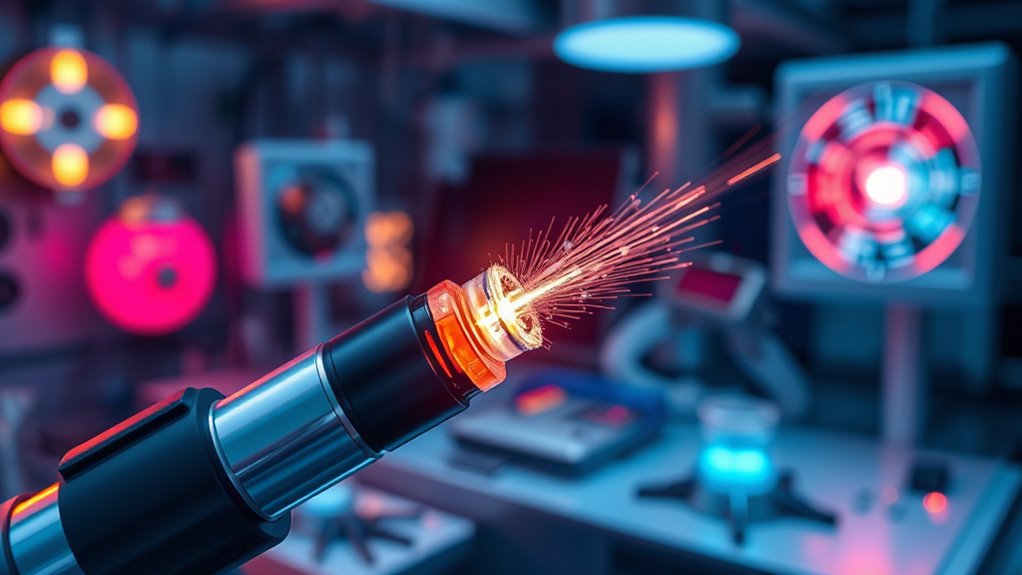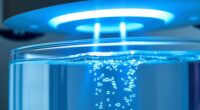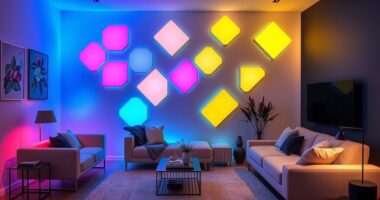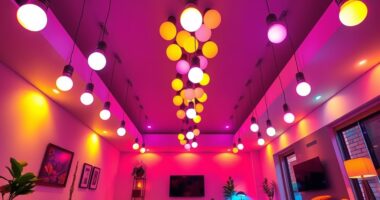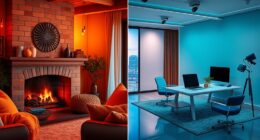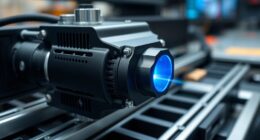If you’re looking for the 14 best fiber optic inspection scopes for precise diagnostics in 2025, I’ve got you covered. I’ve reviewed top models featuring high resolution, flexible probes, and durable builds suitable for various industrial, automotive, and field uses. Whether you need dual-lens cameras, waterproof options, or portable handheld units, there’s something for every inspection need. Keep exploring to discover detailed features and how each tool can enhance your diagnostic accuracy.
Key Takeaways
- The list features top fiber optic inspection scopes with high-resolution imaging, flexible probes, and durable designs for precise diagnostics.
- It covers various models suitable for industrial, automotive, medical, and field applications, including dual-lens and waterproof options.
- Emphasizes ease of use with built-in screens, app connectivity, and portable, lightweight construction for on-the-go inspections.
- Highlights advanced features like auto-focus, high magnification, LED illumination, and compatibility with modern devices.
- Provides insights into environmental resistance, cable flexibility, and accessory compatibility for comprehensive fiber optic inspection needs.
Teslong Two-Way Articulating Borescope with Light

If you’re looking for a versatile borescope that’s easy to control in tight spaces, the Teslong Two-Way Articulating Borescope with Light is an excellent choice. Its 5-foot semi-rigid gooseneck offers a perfect balance of flexibility and stability, making navigation through complex or confined areas straightforward. The 4.5-inch IPS LCD screen provides sharp, high-resolution visuals without needing an app, and built-in LED lights ensure clear visibility in dark environments. Designed for comfort, its ergonomic joystick allows effortless one-handed operation, while its lightweight build reduces fatigue during extended inspections. Whether for automotive, household, or industrial use, this tool delivers precise, detailed inspections with ease.
Best For: DIY enthusiasts, automotive technicians, and industrial inspectors seeking a flexible, easy-to-use borescope for tight and complex spaces.
Pros:
- Two-way articulating gooseneck provides excellent maneuverability and shape retention for precise control
- High-resolution 4.5-inch IPS LCD screen offers clear visuals without requiring an app
- Ergonomic joystick and lightweight design enhance comfort and reduce fatigue during prolonged use
Cons:
- Semi-rigid cable may be less flexible than fully flexible options in very tight or intricate environments
- Built-in LED lights, while adjustable, may have limited brightness in extremely dark conditions
- No Wi-Fi or app connectivity might limit options for remote viewing or advanced image management
Komshine Fiber Optic Inspection Video Probe (KIP-600V)
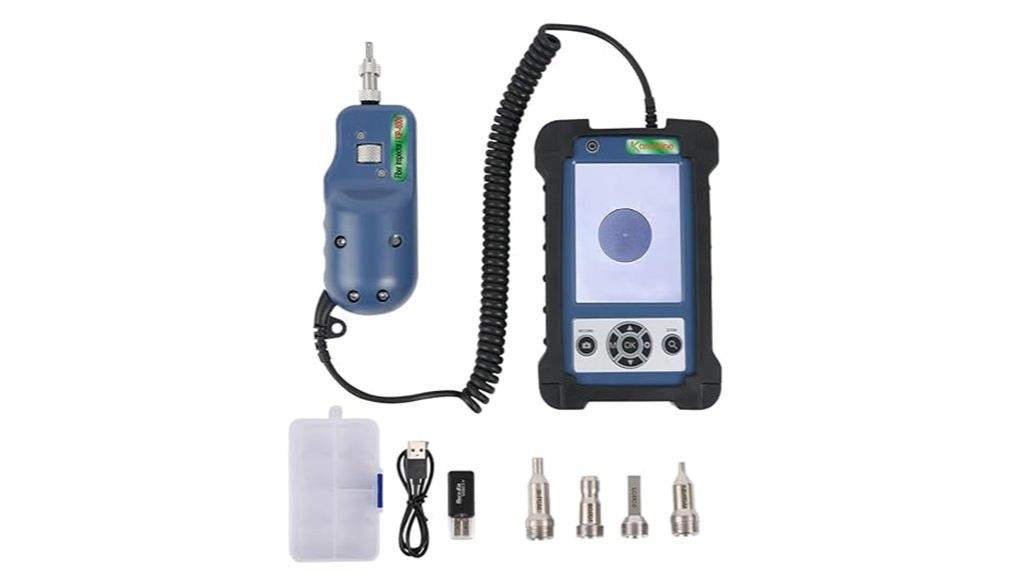
The Komshine Fiber Optic Inspection Video Probe (KIP-600V) stands out for its 3.5-inch HD LCD display, making it an excellent choice for professionals who need clear, detailed visuals during inspections. Its 400x magnification reveals stains and pollution with precision, while the micro sensor with 300,000 pixels ensures detailed imaging. The device supports real-time video recording via TF card, enabling quick data review. With a 4,000mAh battery offering up to 20 hours of standby, it’s suitable for extended outdoor work. Compact and lightweight, it features a durable design with a removable silicone case and a rotary metal bracket for stability and ease of use.
Best For: professionals and technicians needing detailed, portable fiber optic inspection with high-resolution visuals and extended battery life.
Pros:
- Clear 3.5-inch HD LCD display with 400x magnification for detailed inspections
- Long-lasting 20-hour standby battery ideal for outdoor and extended use
- Durable, lightweight design with removable silicone case and stability-enhancing rotary bracket
Cons:
- Limited to specific connector types (FC, SC, ST, LC), which may require adapters for some equipment
- Micro USB charging port might be less convenient compared to newer USB-C options
- The device’s compact size could be challenging for users requiring larger control interfaces
Handheld Fiber Optic Microscope Inspection Tool with Adapters
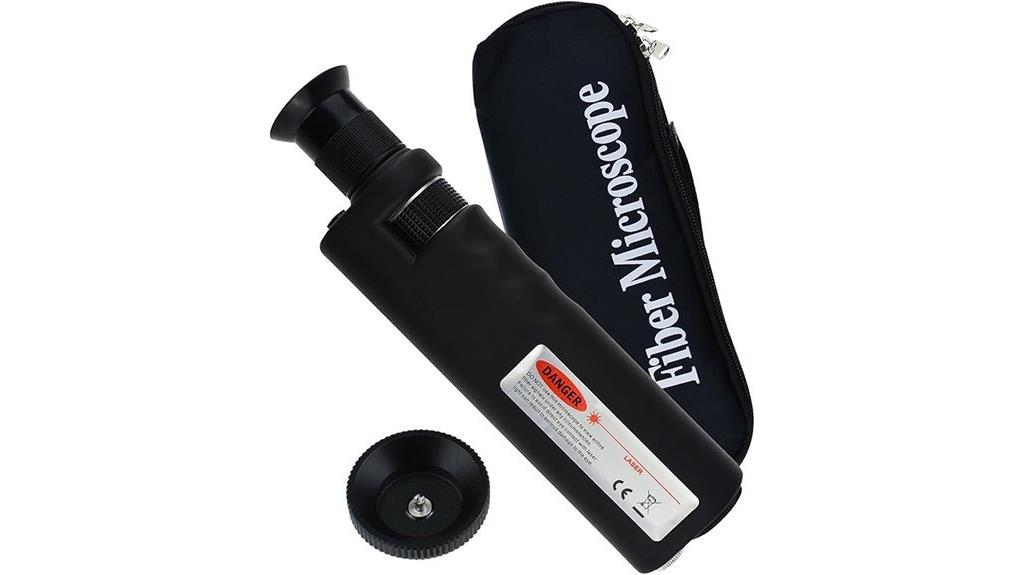
For professionals and enthusiasts seeking detailed fiber optic inspections, the Handheld Fiber Optic Microscope Inspection Tool with Adapters stands out thanks to its 400x optical magnification. This level of detail allows me to examine microstructures with precision, making it ideal for both troubleshooting and quality checks. The built-in LED illumination ensures bright, clear visuals, even in low-light conditions. Its compatibility with both 2.5mm and 1.25mm adapters means I can easily connect it to a variety of devices. Designed with durability and a non-slip rubber housing, it’s comfortable to handle, stable during use, and perfect for in-depth fiber optic analysis.
Best For: professionals, hobbyists, and enthusiasts seeking detailed, reliable fiber optic inspections with versatile device compatibility.
Pros:
- 400x optical magnification provides highly detailed views of microstructures.
- Built-in LED illumination ensures bright, clear visuals in various lighting conditions.
- Includes both 2.5mm and 1.25mm adapters for broad device compatibility.
Cons:
- May be more expensive than basic inspection tools.
- Requires some familiarity to maximize detailed inspection capabilities.
- Non-slip rubber housing, while durable, may slightly increase the overall size for very tight spaces.
Fluke FI-500 FiberInspector Micro Endface Inspection Scope Camera
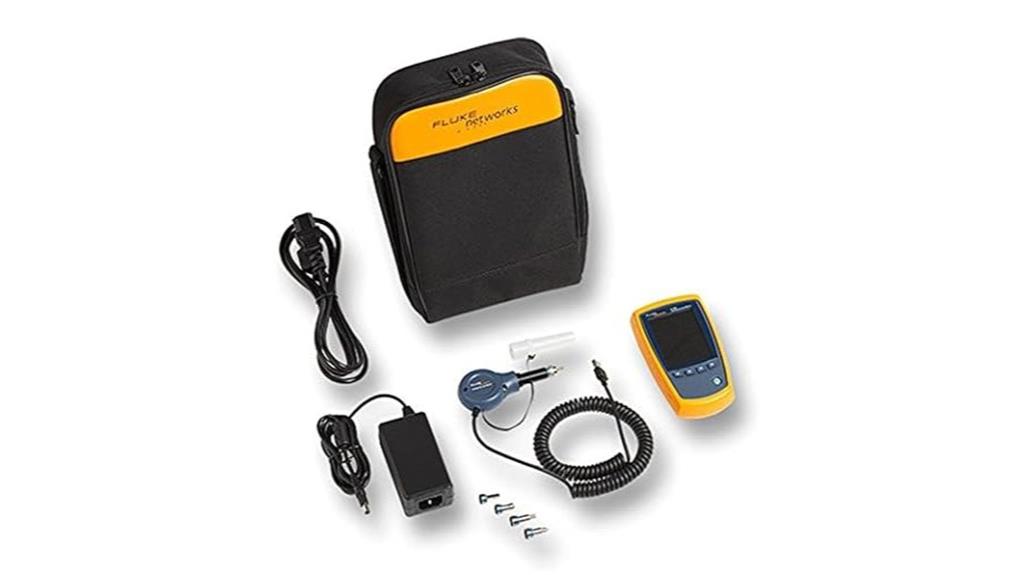
Designed for technicians who need high-resolution, precise inspections, the Fluke FI-500 FiberInspector Micro stands out with its 5-megapixel probe camera and large backlit display. Its 1/4 inch CMOS sensor captures sharp images, making it easier to spot contamination or damage. The auto-focus and autocenter features ensure stable, accurate imaging in seconds. With 200x magnification and multiple zoom options, I can examine fiber ends in detail. Its compact design fits into tight spaces, and the built-in flashlight helps in dark environments. Overall, it’s a reliable tool that simplifies inspecting fiber connectors for quality and maintenance.
Best For: technicians and network professionals who require high-resolution, precise fiber endface inspections in tight spaces and high-density environments.
Pros:
- High-resolution 5-megapixel camera with sharp, detailed images.
- Compact, lightweight design ideal for confined spaces and on-the-go use.
- Built-in flashlight and adjustable zoom for versatile inspections in various lighting conditions.
Cons:
- May be more expensive compared to basic fiber inspection tools.
- Requires some training to fully utilize advanced features like auto-focus and autocenter.
- Battery life could be limited during extensive fieldwork without frequent recharging.
USB C Endoscope Camera with Light, Teslong Type-C Snake Borescope Camera

If you’re looking for a versatile inspection tool that works seamlessly with modern devices, the USB C Endoscope Camera with Light from Teslong stands out. Its USB-C plug ensures broad compatibility with iPhone 15, iPad Pro, Android phones, and tablets—no WiFi or complicated setup needed. Just download the app, connect, and get started. The plug-and-play design makes it easy to use right away. It features 8 high-intensity LED lights with a white balance adjuster, providing clear visibility in dark spaces. The flexible, waterproof (IP67) cable stretches 10 feet, making it perfect for plumbing, automotive, or confined-space inspections.
Best For: DIY enthusiasts, professionals, and outdoor explorers seeking a versatile, easy-to-use inspection camera compatible with modern devices.
Pros:
- Broad device compatibility with USB-C ports, including iPhone 15, iPad Pro, and Android devices
- Plug-and-play operation with no additional setup or WiFi required
- Waterproof IP67 rated cable with 10-foot length for flexible access in tough environments
Cons:
- Requires a compatible device with a USB-C port; not suitable for devices with other connectors without adapters
- Limited to devices that can run the compatible app; may need updates or specific software versions
- The 10-foot cable, while flexible, may be cumbersome in very tight spaces or for delicate maneuvers
Fiber Optic Inspection Microscope with LED, Handheld, Anti-Slip Rubber, SC/LC/FC Connection

The Fiber Optic Inspection Microscope with LED, Handheld, Anti-Slip Rubber, and SC/LC/FC connections stands out as an ideal choice for technicians and field engineers who need reliable, portable inspection tools. It features 400x LED illumination that delivers bright, detailed images for precise fiber analysis. The laser filter guarantees eye protection, making inspections safer. Its universal adapters for 2.5mm and 1.25mm connectors allow compatibility with SC, LC, and FC types. The smooth focus control and easy-on/off switch make operation straightforward. This microscope combines durability, safety, and versatility, making it a top pick for on-the-go fiber diagnostics.
Best For: technicians and field engineers seeking a portable, reliable fiber optic inspection tool with comprehensive connector compatibility and eye protection features.
Pros:
- Provides 400x magnification with bright LED illumination for detailed fiber analysis
- Equipped with laser filter for safe inspection and eye protection
- Compatible with multiple fiber connectors via universal adapters (SC, LC, FC)
Cons:
- Handheld design may cause some instability during prolonged use
- Requires batteries or power source for LED illumination (not specified)
- Limited to 400x magnification, which may not suit very high-precision inspection needs
Teslong Endoscope Borescope with Light, Waterproof Inspection Camera for Automotive and Home Use

For those tackling automotive repairs or home inspections, the Teslong Endoscope Borescope stands out with its bright, adjustable LED lighting and waterproof design. Its 8 LEDs guarantee clear images even in dark, tight spaces. The 30-80mm focusing lens and 78° wide viewing angle make it perfect for inspecting small parts. The 180° rotating display and 1.5x zoom improve detail analysis. With a flexible 16.5-foot semi-rigid cable, it reaches hard-to-access areas and maintains shape. Rated IP67, it’s durable in wet, dusty environments. The device supports photo, video, and freeze frame capture, making documentation quick and easy.
Best For: DIY enthusiasts, mechanics, and home inspectors needing a reliable, waterproof inspection camera for tight spaces and detailed documentation.
Pros:
- Bright, adjustable LED lights provide clear images even in dark environments.
- Flexible semi-rigid cable reaches difficult areas while maintaining shape for precise positioning.
- Supports photo, video, and freeze frame capture for easy documentation and sharing.
Cons:
- SD card not included, requiring an additional purchase for storage expansion.
- Battery life may be limited to around 3 hours of continuous use.
- Some users may find the 8mm probe size restrictive for very small or intricate spaces.
Teslong Inspection Camera with Dual Lens, 16.5FT Waterproof Endoscope
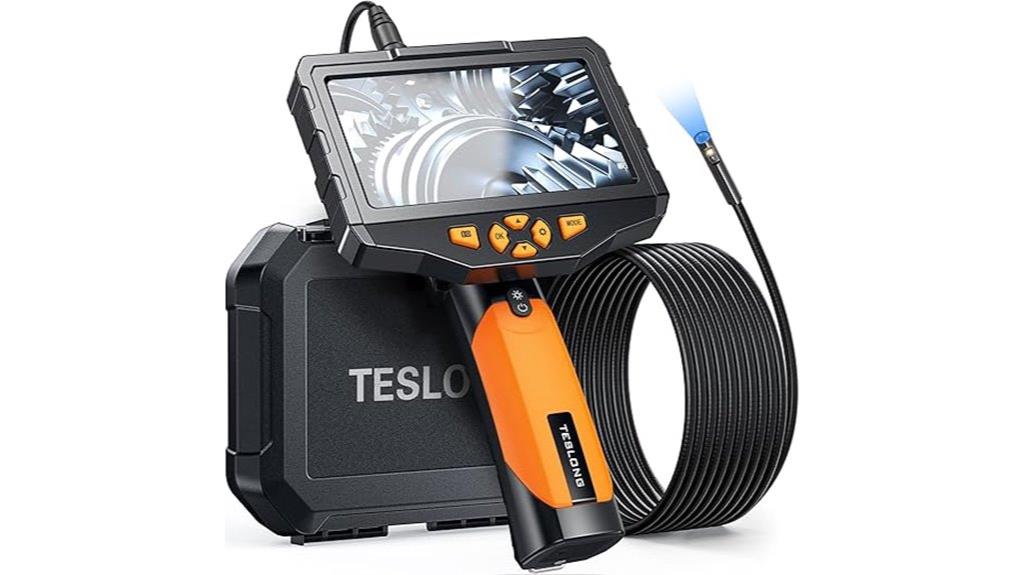
Designed for tough inspections, the Teslong Dual Lens Endoscope stands out with its versatile dual lens system, allowing you to switch seamlessly between main and side views. Each lens is equipped with six adjustable high-intensity LEDs, ensuring clear visibility in dark or low-light environments. The main lens offers a focus range of 30-100mm, while the side lens covers 20-60mm, making it ideal for detailed and wide-area inspections. Its 16.5-foot waterproof design with an IP67 rating lets you venture into wet or challenging spaces confidently. The 5-inch HD IPS LCD screen provides crisp images, and the built-in rechargeable battery offers around 4.5 hours of continuous use.
Best For: DIY enthusiasts, industrial inspectors, and automotive professionals needing detailed, waterproof inspections in tight or challenging spaces.
Pros:
- Dual lens system with adjustable LED lights provides versatile and clear viewing options.
- Waterproof IP67 rating and durable construction suitable for harsh environments.
- Long 16.5-foot cable offers extended reach for comprehensive inspections.
Cons:
- Battery life of approximately 4.5 hours may require frequent recharging during intensive use.
- Charging time of about 5 hours could lead to downtime between inspections.
- The 5-inch screen, while clear, may be less portable compared to smaller devices for on-the-go inspections.
KOMSHINE KIP-600V Fiber Optic Video Inspection Probe

If you’re seeking a fiber optic inspection scope that delivers detailed visuals and ease of use, the KOMSHINE KIP-600V stands out with its 400X magnification and 3.5-inch HD LCD display. It provides clear, real-time images of fiber connectors and supports recording videos directly to an expandable TF card. Compatible with various connectors, including FC, SC, LC, and ST UPC types, it also offers optional APC adapters. The device features a powerful 4000mAH battery, providing up to 20 hours of operation, and a durable removable silicon case. Its high-quality sensor and user-friendly design make it a thorough solution for precise fiber optic inspections.
Best For: professionals and technicians needing detailed, real-time fiber optic connector inspection with recording capabilities and broad connector compatibility.
Pros:
- High 400X magnification with a clear 3.5-inch HD LCD display for detailed visuals
- Supports real-time video recording and data playback with expandable TF card
- Long battery life of up to 20 hours and durable removable silicon case for enhanced portability and protection
Cons:
- May require familiarity with fiber optic connectors and inspection procedures for optimal use
- Slightly bulky design could be less convenient for tight or hard-to-reach spaces
- Optional adapters for APC connections might add to overall cost and complexity
Optic Fiber Cleaning Inspection Kit with Microscope and Cleaning Tools
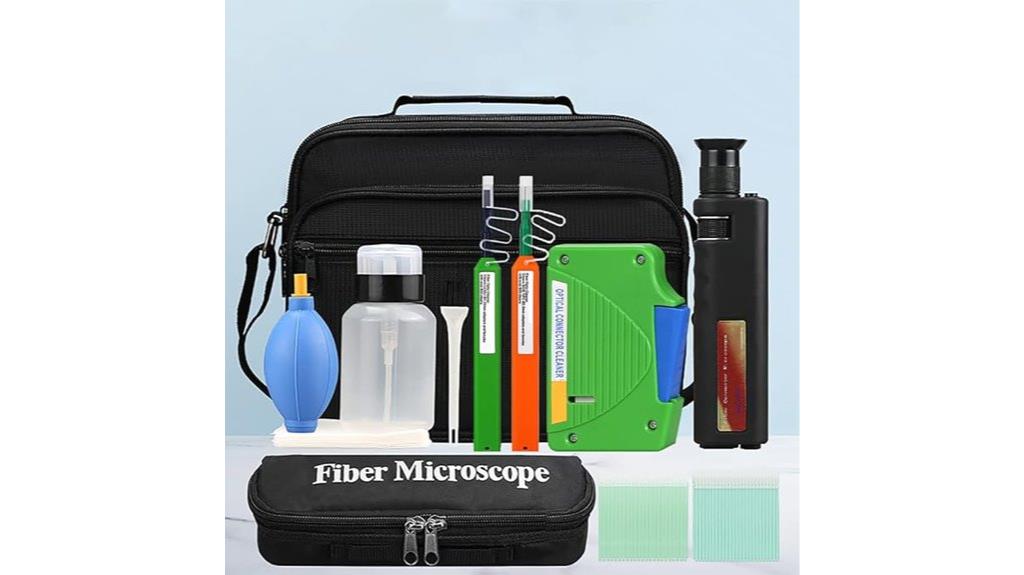
The Optic Fiber Cleaning Inspection Kit with Microscope and Cleaning Tools stands out as an essential choice for professionals who demand precise fiber connector inspection and cleaning. It features a 400x microscope compatible with LC, MTP, MPO, SC, FC, and ST connectors, making detailed inspections straightforward. The kit includes lightweight, manual cleaning tools with replaceable cores and high-density textile tapes that remove dust, oil, and debris without alcohol or solvents. These anti-static tapes last over 550 uses, ensuring efficient, high-quality cleaning. With visual verification capabilities and reliable cleaning tools, this kit helps maintain ideal fiber performance, making it a must-have for any fiber optic technician.
Best For: professional fiber optic technicians and network installers seeking precise inspection and thorough cleaning of fiber connectors.
Pros:
- Compatible with multiple connector types including LC, MTP, MPO, SC, FC, and ST for versatile use
- High-quality cleaning tapes with over 550 uses each, ensuring cost-effective and efficient maintenance
- Includes a 400x microscope for detailed visual inspection, enhancing accuracy and fiber performance
Cons:
- Manual operation may require some skill or experience to achieve optimal results
- Slightly bulky packaging could be less convenient for on-the-go field work
- Limited to fiber connector cleaning and inspection; not suitable for other fiber optic maintenance tasks
Teslong Articulating Borescope with Dual Lens Endoscope

For professionals who need versatile and detailed inspections, the Teslong Articulating Borescope with Dual Lens Endoscope stands out with its dual camera system. It features both forward-facing and side-viewing lenses, allowing seamless switching between angles for thorough examination. The 5-inch IPS screen delivers sharp, vibrant images, ensuring no detail is missed. Its flexible, two-way articulation probe easily navigates tight spaces, maintaining clear visibility in challenging areas. Compact and lightweight, it’s perfect for on-the-go use. Built with durable materials, this borescope is designed to withstand industrial conditions, providing reliable performance for precision diagnostics.
Best For: professionals and DIY enthusiasts seeking versatile, detailed inspections in confined or hard-to-reach spaces.
Pros:
- Dual camera system with forward-facing and side-viewing lenses for comprehensive inspection angles
- High-resolution 5-inch IPS screen provides clear, vivid images for detailed analysis
- Flexible, two-way articulation probe easily navigates tight and challenging spaces
Cons:
- May be heavier or bulkier compared to simpler borescopes, affecting portability for some users
- Requires some familiarity to switch between camera views seamlessly during inspection
- Higher cost due to advanced features might be a consideration for budget-conscious users
Teslong Articulating Borescope with Dual Lens Endoscope Camera

Designed for professionals and serious hobbyists alike, the Teslong Articulating Borescope with Dual Lens Endoscope Camera stands out with its two-way articulated design and dual cameras, providing extensive views in tight or hard-to-reach spaces. Its flexible 5-foot semi-rigid probe and built-in high-brightness LEDs guarantee clear visibility even in dark, confined areas. The 4.5-inch IPS LCD screen offers high-resolution, vivid visuals without needing an app. With intuitive controls like a central joystick and multifunction button, it’s easy to operate for quick camera switching, photo capturing, and video recording. Lightweight and compact, it’s perfect for detailed inspections across automotive, household, and industrial applications.
Best For: professionals and serious hobbyists seeking a versatile, high-resolution borescope for detailed inspections in tight or hard-to-reach spaces.
Pros:
- Dual cameras (front and side view) provide comprehensive inspection angles
- Adjustable high-brightness LED lights ensure clear visuals in dark areas
- User-friendly interface with intuitive joystick and multifunction button for quick operation
Cons:
- Slightly heavier at approximately 3.17 pounds, which may cause fatigue during extended use
- Requires familiarity with technical inspection tools for optimal operation
- Limited to specific lengths and features, potentially less suitable for very long or specialized inspections
10FT Articulating Borescope with 1080P Camera and Light

If you need a reliable inspection tool that combines flexibility with high-resolution imaging, the FT Articulating Borescope with 1080P Camera and Light stands out. Its 10-foot semi-rigid, waterproof gooseneck cable, with a tiny 0.33-inch camera head, easily navigates tight spaces. The two-way articulating tip offers precise control, while the optimized bending radius of just 29mm makes it perfect for small-diameter pipes. The 1080P camera delivers clear images, even in low-light conditions, thanks to built-in illumination. Compact and lightweight, the 4.3-inch monitor and rechargeable battery make it easy to operate and transport, enhancing versatility across various inspection tasks.
Best For: professionals in non-destructive testing, remote visual inspection, and maintenance seeking a versatile, high-resolution borescope for tight and hard-to-reach spaces.
Pros:
- High-resolution 1080P camera with built-in light for clear imaging in various environments
- Flexible, articulating tip with two-way steering for precise maneuverability in complex spaces
- Compact, lightweight design with a rechargeable battery and portable case for easy transport and operation
Cons:
- Limited to approximately 4 hours of continuous use per charge, which may require planning for longer inspections
- Slightly higher cost compared to basic or less advanced borescopes, but offers better features and image quality
- The semi-rigid cable may be less flexible than fully flexible models in extremely tight or complex pathways
Teslong 3.9mm Two-Way Articulating Borescope with Light

The Teslong 3.9mm Two-Way Articulating Borescope stands out with its precise 2-way articulation, making it ideal for professionals who need to navigate confined spaces with ease. Its ultra-thin 3.9mm flexible probe easily accesses tight areas like engine cylinders and wall cavities. The 5-inch IPS LCD screen delivers true-color images, ensuring clear, vivid visuals right out of the box. With wireless connectivity, sharing inspection images with colleagues is seamless, supporting real-time analysis. The lightweight design and included accessories, such as a microSD card and carrying case, make it a practical tool for automotive, mechanical, and interior inspections.
Best For: professionals and enthusiasts in automotive repair, mechanical inspection, and interior wall examination seeking a precise, easy-to-use borescope with real-time sharing capabilities.
Pros:
- Precise 2-way articulation for easy maneuverability in confined spaces
- Ultra-thin 3.9mm flexible probe for accessing tight areas like engine cylinders and wall cavities
- Built-in wireless connectivity enables seamless image sharing and real-time inspection analysis
Cons:
- Limited to a 5-inch display, which may be small for some detailed inspections
- No external hardware or software required, but this could limit advanced customization options
- Battery life and charging time are not specified, potentially affecting extended use
Factors to Consider When Choosing Fiber Optic Inspection Scopes

Choosing the right fiber optic inspection scope depends on several key factors. I look at compatibility with my inspection environment, as well as the scope’s magnification, resolution, and flexibility. Considering these points helps guarantee I select a device that’s durable, portable, and suited to my specific diagnostic needs.
Inspection Environment Compatibility
Selecting the right fiber optic inspection scope requires careful attention to its compatibility with your inspection environment. First, check the waterproof rating—an IP67 rating is ideal for environments with moisture or dust exposure. Next, verify the scope’s temperature tolerance and material durability to guarantee it can withstand harsh conditions like high heat, chemicals, or abrasives. Adjustable illumination, such as built-in LEDs, is vital for visibility in low-light or confined spaces. Also, consider the cable’s length and flexibility to reach all areas, including tight or deep locations. Finally, confirm the scope’s connectors or adapters match your existing equipment for seamless data transfer. Matching these factors guarantees reliable, effective inspections regardless of environmental challenges.
Magnification and Resolution
Magnification and resolution are essential factors when picking a fiber optic inspection scope because they directly impact your ability to identify defects, dirt, or misalignment. Higher magnification, like 400x or more, allows you to see fiber end faces in detailed clarity, making it easier to detect tiny contaminants or damage. Resolution, measured by pixel count and sensor quality, determines the sharpness and clarity of the images, fundamental for precise diagnostics. A scope with at least a 1/3-inch sensor and 300,000 pixels generally provides enough detail for most inspections. It’s imperative to balance magnification and resolution with the scope’s field of view, ensuring you can see enough of the fiber while still catching fine imperfections. Adjustable magnification scopes offer the flexibility needed for thorough inspections.
Probe Flexibility and Length
The flexibility and length of a fiber optic inspection scope’s probe substantially affect how easily you can access and examine challenging areas. A flexible probe can navigate tight bends and complex connector geometries without damaging the fiber endface, making it ideal for confined spaces. Longer probes, such as 5 to 10 feet, improve access to hard-to-reach spots but can reduce maneuverability, making precise control more difficult. Semi-rigid probes strike a balance, offering stability and flexibility for precise positioning in tight environments. Articulating or two-way adjustable probes provide directional control, essential for inspecting uneven or complex surfaces. The bending radius also matters; smaller radii allow better navigation through small-diameter connectors and tight spaces, enhancing overall inspection versatility.
Lighting and Illumination Features
Lighting and illumination are essential when choosing a fiber optic inspection scope because they directly impact how clearly I can see inside dark or confined spaces. I look for scopes with adjustable LED or built-in lights that let me customize brightness, ensuring I avoid overexposure or under-illumination. Even light distribution is vital to prevent shadows or glare that can hide details. For tough environments, waterproof or IP-rated lighting features are a must, especially when working in wet or dusty conditions. High-quality illumination helps me detect contamination, damage, or dirt on fiber end faces more accurately. Ultimately, good lighting makes a significant difference in achieving precise diagnostics, making my inspections more reliable and efficient.
Device Durability and Portability
When selecting a fiber optic inspection scope, prioritizing durability and portability is essential because these factors directly influence how reliably and easily I can perform inspections in challenging environments. A durable scope features an impact-resistant outer shell that withstands drops and rough handling, ensuring longevity. Portability is boosted by lightweight, compact designs, often with integrated carrying cases or strap attachments, making transport effortless. Waterproof and dustproof ratings like IP67 guarantee the device operates reliably in harsh conditions without damage. Flexible yet sturdy cables, such as semi-rigid goosenecks, allow precise maneuvering while resisting wear. Additionally, long-lasting batteries with high capacity support extended use in the field, minimizing recharging interruptions. Together, these features ensure my inspection tools are both tough and easy to carry anywhere.
Frequently Asked Questions
What Is the Optimal Resolution for Detailed Fiber Optic Inspections?
The ideal resolution for detailed fiber optic inspections is typically around 1 micron or better. I aim for scopes that offer high magnification and clarity, so I can identify tiny defects or contaminants accurately. With this resolution, I can confidently assess fiber cleanliness, end-face conditions, and connector integrity. Investing in a scope with superior resolution ensures I don’t miss critical issues, saving time and preventing future network failures.
How Do Different Lighting Options Impact Inspection Clarity?
Lighting options can make or break your inspection clarity—I’ve seen it happen, and it’s shocking! Bright LED lights provide sharp, consistent illumination, revealing even tiny flaws. Adjustable lighting lets me tailor brightness to specific areas, preventing glare and shadows. Meanwhile, fiber-optic illumination offers flexibility in tight spots. Choosing the right lighting guarantees I get crystal-clear images, making diagnostics accurate and efficient. Don’t underestimate the power of good lighting!
Are There Specific Scopes Suitable for Hazardous or Confined Environments?
Yes, there are specialized scopes designed for hazardous or confined environments. I recommend looking for models with explosion-proof or intrinsically safe certifications, which prevent sparks and contain any potential hazards. Flexible, compact scopes with excellent maneuverability help navigate tight spaces safely. These tools often feature durable construction and clear imaging, ensuring you can perform inspections accurately without risking safety or damaging sensitive areas.
How Does the Scope’s Durability Affect Long-Term Usage?
A durable scope is essential for long-term use, especially in demanding environments. For example, I’ve seen technicians rely on ruggedized scopes that withstand drops and exposure to chemicals, ensuring consistent performance over years. When a scope’s build quality is solid, it reduces the risk of damage and costly replacements. This means I can focus on diagnostics without worrying about equipment failure, ultimately saving time and money in the long run.
What Accessories Enhance the Versatility of Fiber Optic Inspection Scopes?
I find that accessories like different lens tips, LED light attachments, and flexible extension cables really boost the scope’s versatility. These additions allow me to adapt to various inspection scenarios, from tight spaces to complex fiber arrangements. Using specialized lenses helps me get clearer images, while extra lighting improves visibility in dark areas. Overall, these accessories make my inspections more precise and efficient, saving me time and effort.
Conclusion
When choosing a fiber optic inspection scope, I look for clarity, flexibility, and reliability. I want tools that see deep, adapt easily, and last long. Because precision matters, I seek devices that deliver sharp images, smooth articulation, and consistent performance. Ultimately, the right scope isn’t just about features—it’s about empowering me to diagnose accurately, work confidently, and achieve results with every inspection. Because when I choose wisely, I inspect thoroughly, diagnose confidently, and perform flawlessly.
